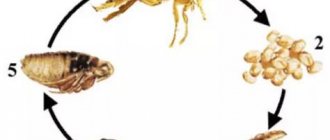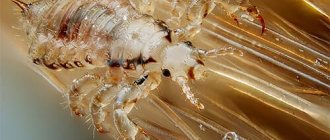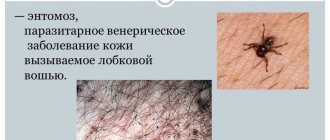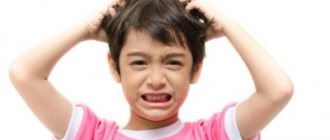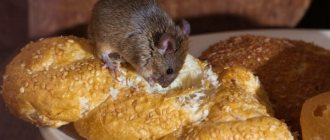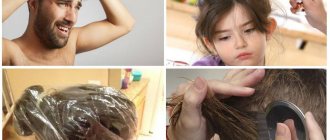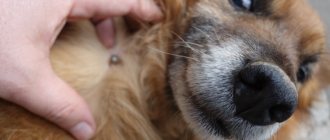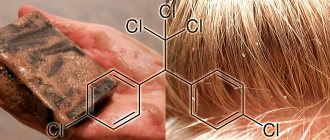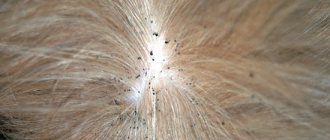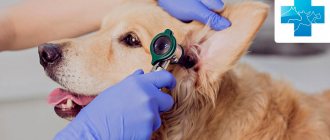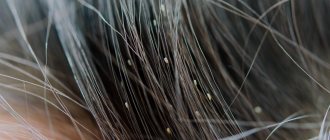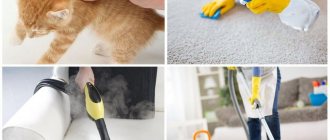- about the author
- VK profile
Svetlana Tarasova
Hairdresser-stylist with more than 8 years of experience, expert in the field of haircuts, styling, hair care, coloring.
Everyone knows about such a disease as pediculosis in humans. But it turns out that lice can also infect dogs! This problem should not cause much concern for owners of four-legged animals, since it can be eliminated without any problems.
Do dogs have lice and nits, what do they look like and can they live long?
Dogs, like many other animals, can carry lice and nits. They can be identified by careful examination of the animal's fur.
Nits look like small white grains attached to the fur, most often located closer to the root part. In appearance they resemble dandruff. The life cycle of a nit lasts 21 days.
Lice are usually small, yellow-gray in color, have a narrow, flattened, elongated body and an elongated head. Visually, you can see a clear division into a narrow head, chest and abdomen. There are no eyes, the mouthparts are of the piercing-sucking type, and there are claws on the paws. Parasites are most often localized on the tips of the ears, near the eyes, around the anus and in places where the fur gets tangled.
Without a host, lice live no more than 3 days. The process of treatment and complete recovery takes up to 30 days.
Antiparasitic collars
Collars, which are impregnated with special insecticidal compounds, are used not only to combat lice, but also to prevent it. Removing lice takes from one to two weeks.
Among the disadvantages of the method are a high level of allergenicity and the possibility of damaging the fur in the place where the product is worn.
The most popular collar parkas are:
- Foresto (Bayer);
- Beaphar;
- Green Fort;
- RolfClub 3D;
- Api-San Dana Ultra.
The choice of the type of antiparasitic drug is best left to the treating veterinarian, who will take into account the size, age and physiological condition of the dog.
Important point!
Since the insecticide is not able to kill lice eggs, treatment must be carried out until the entire colony of parasites is destroyed.
Types of lice in dogs, the difference between lice and fleas, why lice are dangerous for an animal
There are two types of lice found in nature that infect dogs:
- Trichodectes canis (lice eaters) – chewing or biting lice. They are distinguished by a flat, blunt head. They feed on epidermal cells and sebaceous secretions of the skin. They are carriers of tapeworms. They feed on dog fluff and skin scales.
- Linognathus setosus - sucking lice. They are more common in regions with cold climates. Affects long-haired dogs. Characterized by a pointed proboscis. They feed on the blood and lymph of dogs.
The flea's body has a laterally compressed shape, covered with scales, bristles and spines. The flea can reach 5mm in length, and sometimes more.
Important! To distinguish a flea from a louse, look at their mode of movement. Lice run very quickly, and fleas move by jumping.
Lack of adequate treatment for parasites threatens the dog with depression of the nervous system, exhaustion, anemia, and infection with helminths . Also, lice can provoke the appearance of purulent wounds and skin diseases (dermatitis, eczema, etc.)
Symptoms
The activity of lice causes severe itching. They accumulate on the edges of skin defects resulting from flea activity and feed on ichor. The dog scratches the affected areas. Additional scratches attract new hordes of insects. Tangles form.
Lice make your dog itch
If lice act in company with lice-eaters, areas of baldness form. The animal is depressed. The following diseases develop:
- Insomnia. Itching prevents the dog from sleeping.
- Aggressiveness.
- Dermatitis.
- Eczema.
- Anemia.
- Exhaustion.
- Seborrhea. Appears with low lice infestation.
Symptoms of lice and nits in dogs, causes and routes of infection
To detect lice on a dog, it is enough to examine the pet. Adults can be seen with the naked eye, and when combing the fur, white nits will stick to the hairs, unlike dandruff.
Reference! If you wet the skin of a lice-infested dog, you can smell the mice.
Symptoms of linognathosis disease:
- Constant itching.
- The animal bites insects.
- The coat loses its shine, has an unkempt appearance, becomes matted, and may fall out.
- Skin disorders, dermatitis, dryness, redness.
- Bald spots appear.
- The dog is losing weight.
- Sores and suppuration appear at the bite sites.
- Developmental delay in puppies.
- Sleep disturbance, depression.
- Anemia – when severely affected by parasites, most often occurs in small breeds of dogs and puppies.
Important! Skin rashes can be caused not only by lice infestation, but also by other reasons.
Lice infection can only be caused by contact with a sick animal. But it is worth remembering that a weakened, elderly or young body is more likely to get sick.
Routes of infection:
- From a sick dog to a healthy one.
- From infected mother to puppies.
- While hunting some animals (wolf, arctic fox).
- When living together in kennels, shelters, dog hotels.
- In case of severe infestation, infection is possible through common care items: beds, bedding, combs, upholstered furniture, carpeting.
- Through poorly processed grooming tools.
- Sometimes infection occurs through the shoes and clothing of a person who has been in contact with an infected dog.
Important! Most often, lice disease progresses during the cold season.
Cat flea and dog fleas
Fleas are external parasites that live on the skin of their prey. Flea bites from cats and dogs are a widespread problem. But did you know that cats and dogs are most often affected by cat fleas? Fleas create problems for both animals and their owners. Cat and dog fleas affect not only cats, dogs and people, but also many other animals. Humans are predominantly affected by cat fleas.
Cat and dog fleas are similar in appearance and body structure. Cat and dog fleas can live on both cats and dogs equally. The cat flea (Ctenocephalides felis) and the dog flea (Ctenocephalides canis) are the most common types of fleas found in and around homes. Summer is the favorite time of fleas.
The difference between a cat flea and a dog flea is minimal. The female of both species is about 2.5 mm long. The male is slightly smaller than the female. The head of a female cat flea is almost twice as long as its height, and the head of a female dog flea is half as long as its height.
Find out more: KFU scientists are working on creating an artificial intelligence system for urologists
Cat and dog flea larvae are almost twice as long as adults. Particles of dried blood, excrement and various organic particles that accumulate on the affected areas provide enough nutrition for the rapidly growing larvae. With a very severe infestation, a large number of gray larvae and white eggs become so noticeable that there is no doubt about the infestation.
You can remove adult fleas from cats and dogs, but the eggs will remain. The larvae emerge from the eggs in about 14 days, depending on humidity. A flea lives for less than two months, but a female flea usually lays more than 2,000 eggs.
Fleas on dogs. There is another interesting fact. Fleas can jump up to 100 times their body height. They can jump up to 15 cm in height and attach to skin or clothing.
Flea infestation often causes secondary infections. If a dog or cat is infected with fleas, the help of a veterinarian is required, who will suggest effective control measures.
Animals are predisposed to allergies to flea saliva, which often results in flea allergy dermatitis. Symptoms of dermatitis: swelling, unbearable itching, red, tiny bumps on the skin, thickening of the skin, redness of the skin, hair loss, bald patches. Cat and dog fleas can bite people too.
Can lice and nits be transmitted from a person to a dog and can a person become infected from a dog?
Lice are a specific type of parasite. They can be transmitted and live only on the host species and feed only on the host's blood. Therefore, humans cannot become infected with dog lice . A dog louse can get on a person and even bite him, but the parasite will not be able to survive in the new conditions and will die.
Likewise, human louse cannot be transmitted to a dog even through close contact.
Can children get infected in a pool or lake?
Since the types of lice that live on dogs are not able to survive on humans, there is no risk of infection.
In swimming pools, the water is usually chlorinated and no living organisms can live in it.
In fresh reservoirs with stagnant water, parasites can live for some time, but infection does not occur in the water, but from a sick person (we are talking about lice that infect people).
Diseases caused by lice
What's scary for a dog is not the lice themselves, but the diseases they cause. Infestation can lead to the following problems:
- Eczema and dermatitis. They arise as a response to irritating substances contained in the saliva of lice.
- Various types of suppuration. Lice bite the dog, the dog itches, pathogenic and conditionally pathogenic microflora enter the wounds, and inflammation develops. And at this time, the dog itches further, tears and contaminates the inflamed areas even more... Under such conditions, an abscess or even phlegmon can easily develop.
- Lice contribute to the development of severe fungal infections. Ectoparasites have an extremely negative effect on the immune system, as a result of which it cannot effectively resist threats from the external environment.
Lice are common carriers of infectious diseases, including:
- Lice can carry worm eggs on their paws.
- These parasites are carriers of many infectious diseases, especially of bacterial etiology.
- Lice can carry leptospirosis.
Interesting! Contrary to popular belief, lice cannot tolerate blood parasitic diseases, because The life cycle of Babesia, for example, is strictly tailored to the physiology of ixodid ticks.
How to remove lice from dogs - treatment and the most effective ways to combat parasites
To remove lice, insecticides are used. If necessary, therapy is repeated after 10 days, when new mature individuals may appear from the surviving eggs. After treatment, it is recommended to comb the fur with a thick comb to remove nits or trim the animal.
Unlike fleas (which can jump), lice are unable to escape from a dog's treated fur, making them easier to control.
Types of parasite control products:
- Drops – applied to the withers or along the animal’s spine and rubbed in. May cause allergic reactions.
- Insecticidal sprays - you need to treat all the wool, wait for the time indicated in the instructions and rinse thoroughly.
- Shampoo - applied to the entire coat and rinsed off. Used for treatment and prevention, suitable for small breeds of dogs and puppies. For larger dogs, this treatment is more expensive.
- The collar is easy to use, can also be used for prevention, and eliminates many types of parasites. May cause allergies and skin damage at the site of application.
After lice are removed, wounds, redness, and peeling may remain on the animal’s body, which should be treated with antiseptic and wound-healing medications.
Important! At the end of treatment, the animal must be checked for the presence of helminths.
Pediculicidal shampoos
Shampoos, the composition of which includes insecticidal components, are quite convenient to use, especially in case of infection of puppies and small decorative breeds of dogs.
If we talk about representatives of large breeds, this method will be less effective and quite expensive. To improve the quality of the coat, such shampoos are improved through natural additives and softening ingredients (look for them in the composition).
Note that most manufacturers produce hypoallergenic products that are highly effective, including:
- Bars (Agrovetzaschita);
- Lugovoy;
- BIO-GROOM;
- Le Artis Herba Vitae;
- Iv san bernard.
TOP best remedies against linognathosis in dogs
Drops - destroy parasites and prevent further infection. The active substance accumulates on the skin, in the sebaceous glands and thus has a long-term effect, preventing re-infection. Not absorbed into the blood.
| Name | Compound | Description | Price |
| Leopard | Contains fipronil, diflubenzuron, dicarboximide. | It disrupts the transmission of nerve impulses (causes paralysis), impedes egg laying, disrupts molting, and reduces resistance to insecticides. Can be used from 2 months. Not for pregnant women and sick people. Valid for up to 2 months. | 160 – 270 rub. |
| Frontline | Fipronil | Covers the skin, is retained in the hair follicles and sebaceous glands. Used from 2 months. Protects against parasites for up to 1.5 months. | 400 – 900 rub. |
Shampoos are the most convenient way to treat lice, in addition to the antiparasitic effect, they have moisturizing properties, which reduce itching and improve the quality of the coat. Used to treat puppies and decorative breeds of dogs.
| Name | Compound | Description | Price |
| Celandine | Permethrin | In addition to the insecticidal effect, it protects and nourishes the coat. Not for use in puppies or pregnant dogs. | 150 – 200 rub. |
| Leopard | Essential oils of lavender, costus, cloves, pelargonium | Repels parasites. Can be used in puppies. Safe composition. | 150 – 200 rub. |
| Phytoelite | Permethrin, herbal decoctions | Affects the nerve cells of parasites and causes paralysis. Can be used from 2 months. | 100 – 150 rub. |
Sprays - the active ingredients of sprays envelop the parasite, which contributes to its suffocation. They have almost no effect on nits, which requires additional processing. The difficulty of application is that you need to apply it to the entire coat and leave it on for some time.
Avoid contact with eyes, nose, ears. Often causes allergic reactions.
| Name | Compound | Description | Price |
| Frontline | Fipronil | Covers the skin, is retained in the hair follicles and sebaceous glands. Protects against parasites for up to 2 months. | 800 – 1500 rub. |
| Vet's Best | Clove extract and mint oil | Safe, natural. Can be used from 3 months. | 700 – 800 rub. |
Collars are a universal method of getting rid of lice and fleas at the same time. The accessory is impregnated with active substances that repel pests.
| Name | Compound | Description | Price |
| Bayer Kiltix | Flumethrin | It begins to act within a day after putting it on. The effect lasts 7 months. Suitable for puppies from 2 months and pregnant dogs. | 750 – 1200 rub. |
| Hartz UltraGuard Flea & Tick Collar | Tetrachlorvinphos | The effect of the collar begins immediately after putting it on. The active tape heats up, the poison enters the animal’s body and kills insects. Lasts 7 months. Has a reflective strip and is waterproof. | 900 rub. |
| Scalibor | Deltamethrin | Repels and kills insects. The action begins 7 days after the start of use. Suitable for puppies from 2 months and pregnant animals. | 700 – 1200 rub. |
Prices for drugs
Russia
- Stronghold, drops, 3 pipettes of 1 ml each, from 1550 to 1650 rubles;
- Frontline, drops, 1 pipette, from 515 to 850 rubles;
- Hartz Ultra Guard Plus, 3 pipettes, from 1250 to 1360 rubles;
- BIO-GROOM, shampoo, 947 ml., from 2000 to 2260 rubles;
- Iv san bernard, shampoo, 250 ml., from 380 to 395 rubles;
- Bars (Agrovetzaschita), shampoo, 250 ml., from 165 to 175 rubles;
- GreenFort Neo, spray, 200 ml., from 400 to 430 rubles;
- RolfClub 3D, spray, 200 ml., from 450 to 480 rub.;
- Api-San Dana Ultra, 100 ml., from 260 to 280 rubles;
- Green Fort, collar, from 210 to 230 rubles;
- Foresto (Bayer), collar, from 1500 to 2250 rubles.
Ukraine
- Api-San Dana Spot-On, drops, from 75 to 85 UAH;
- RolfClub 3D, drops, 3 pipettes, from 145 to 155 UAH;
- Stronghold, drops, 3 pipettes, from 620 to 645 UAH;
- Bars (AVZ), spray, 100 ml., from 120 to 130 UAH;
- Beaphar, shampoo, 200 ml., from 215 to 225 UAH;
- Ultra Guard Hartz, shampoo, 200 ml., from 155 to 165 UAH;
- Phytoelite, shampoo, from 45 to 50 UAH;
- Bayer Bolfo, spray, 250 ml., from 175 to 185 UAH;
- RolfClub 3D, spray, 200 ml., from 210 to 230 UAH;
- Api-San Dana Ultra, collar, from 65 to 75 UAH;
- Foresto (Bayer), collar, from 650 to 930 UAH.
How to get rid of lice on dogs at home using folk remedies
Kerosene - apply and distribute throughout the fur (try to get it less on the skin), wrap the animal in cellophane, with a towel on top. Leave for 15 – 30 minutes and rinse with shampoo twice.
Avoid contact of the substance with mucous membranes!
In terms of efficiency, it is inferior to modern means.
Important! Before using kerosene, make sure you are not allergic to it.
Laundry soap - wash the wool with soap for the first time, then apply thick soap foam to the entire surface and leave for an hour, rinse with warm water.
This remedy is not effective enough; it is recommended to be used in combination with other means.
Vinegar (9% is used) – make a solution of 100 ml of vinegar and 200 ml of water, moisten a towel and wrap the animal in it (for a better effect, wrap it in cellophane), leave for 30 minutes and comb out with a comb. Wash with shampoo. Avoid contact with eyes and skin! Combinations of vinegar with mustard, egg, tea tree oil, and vegetable oil are possible.
What are the symptoms
It is not difficult to determine the presence of parasites in an animal, since insects, when they land on the skin, immediately begin to feed on the donor’s blood.
The most obvious signs of lice are:
- Continuous itching caused by parasite bites. The dog is constantly itching, damaging the integrity of the skin. The result is bleeding scratches that attract insects. In the absence of timely treatment, the wounds fester, turning into extensive ulcers.
- The wool loses its luster and bunches up into dense clumps, which can only be gotten rid of by cutting them out. From the areas that the dog scratches more often, the hair gradually falls out and bald spots form.
- Itching from bites does not allow the dog to fully rest. The result is a depressed mood and loss of appetite.
Taking into account the symptoms and analysis of the vital activity of lice, it is possible to determine the degree of danger of infection with lice. Firstly, the animal’s nervous and immune systems suffer. Secondly, loss of appetite leads to gradual exhaustion and weight loss, which contributes to the development of anemia. Thirdly, parasites are the main carriers of larvae of various types of worms. Fourthly, lice are a strong allergen.
Preventing lice infestation in dogs and how to clean your house to prevent the disease
To avoid infecting your dog with lice, you need to:
- prevent her from interacting with sick animals
- clean clothes and shoes after going outside
- keep the dog clean
- bathe once a month with pediculosis shampoo
- wear an anti-parasitic collar when going outside
- check the coat regularly
- give vitamin complexes in the spring and autumn.
Interesting! To prevent lice from multiplying, you need to lubricate your dog's fur and skin with coconut oil.
If an animal becomes infected, immediately after treatment it is necessary to carry out treatment in the house to eliminate possible parasites:
- vacuum carpets, floors, upholstered furniture;
- wash the floor with the addition of chlorine, vinegar or ammonia;
- Thoroughly clean and wash the animal’s area, replace the bedding;
- treat all dog accessories (combs, bowls, etc.) - scald with boiling water or place in boiling water for 10 minutes. Iron soft items after washing.
Reference! To treat premises and bedding, you can use detergents: Tetrix, Tsifoks, Agran, Executioner, Cucaracha.
Traditional methods of treatment
To completely get rid of canine lice, it is necessary to treat the pet with special preparations in several stages. Traditional medicine can only be used as part of a complex of therapeutic measures.
Popular folk remedies:
- rosemary;
- sagebrush;
- tansy;
- geranium;
- eucalyptus.
Decoctions and infusions are prepared from these herbs. For 1 liter of boiled water take 20 grams. dry grass or 40-50 gr. chopped freshly picked. Cook in a water bath for 25-30 minutes. Cover with a lid and cool, filter. The product is applied to the animal’s fur without rinsing off. Treatment is carried out once every three days for a month. Can be used as a prophylactic.
FAQ
Expert opinion
Eve
hair stylist
Ask a Question
Can a Yorkie have lice?
The luxurious coat of Yorkshire Terriers is of great interest to lice. They affect the fur and skin and cause a lot of trouble. The dog should be examined regularly so as not to miss the onset of the disease.
How to remove nits from a husky puppy?
Lice and nits can be removed using special means. When choosing a product, you need to take into account the age and weight of the puppy (the instructions for the drug indicate at what age it can be used). For puppies, drops or shampoos are usually chosen.
How to comb out nits from puppies?
Before combing, you need to wash the hair with a solution of vinegar and water (1:1), this procedure will dissolve the sticky layer that allows nits to stick to the hair. After this, take a thick comb (preferably metal, sold in pharmacies) and comb out the nits, not missing a single area of fur on the animal’s body. The process may take more than one day. Shampooing and combing should be repeated after a week.
Can dogs have pubic lice?
There are only two types of lice that affect dogs: the lice lice and the dog lice. Pubic lice have a special structure of their legs, which allows them to cling only to hair with a triangular cross-section.
